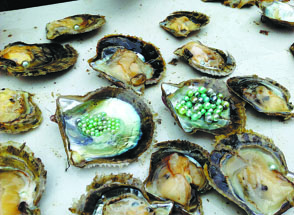Cooperation shining brightly

Editor's Note: People-to-people exchanges are deepening the connections between countries participating in the Belt and Road Initiative. This column celebrates the efforts of those working toward a shared future.
They're quite small and irregular in shape, but that's not the first thing you notice about the seawater pearls nestling in Shi Chengkai's hand. It's the striking colors. The typical pearls sold in the market-large and round-come only in white or black.

"These colors - green, pink, and purple-are all natural and formed with the growth of pearls, and will not fade away no matter how you clean them," says Shi, who began studying and cultivating colored pearls in the 1990s in the city of Beihai, in the Guangxi Zhuang autonomous region.
Unlike some dyeing methods used in the past, Shi uses a special biotechnology known as the directed breeding technique to change the color of the nucleus and cell sheet that are inserted into the Hepu pearl oyster. The very different colors will then be naturally formed during the oyster's secretion of proteins.
The Hepu pearl, widely known as the Southern pearl, is considered the best pearl in China with a history of cultivation going back more than 2,000 years. It is named after its place of cultivation, Hepu county in Beihai, an important stop along China's ancient maritime Silk Road.
This technology has been identified by the region's Department of Science and Technology as a world first, and won the first prize in the Guangxi Science and Technology Progress Award in 2006.
Since 2013, Shi, president of Beihai Yuanlong Pearl, has been busy taking his pearl cultivation technology abroad, and the Belt and Road Initiative has fired up his ambitions along with making available the support he needs.
Agricultural exchanges and trade were vital elements of the ancient Silk Road, and they remain the economic foundation of the countries involved in the Belt and Road Initiative. This enduring legacy makes agriculture an essential element for cooperation among the participating countries.
In May 2017, an action plan for the joint promotion of agricultural cooperation under the initiative was launched by four Chinese ministries and departments: the Ministry of Agriculture, the National Development and Reform Commission, the Ministry of Commerce, and the Ministry of Foreign Affairs.
The plan was conceived to contribute China's wisdom to the global governance on food and agriculture, enabling the nation to share its experiences with BRI countries so as to contribute more to the world's agricultural and economic growth.
Also in 2017, Beihai Yuanlong and the University of Malaysia Sabah reached an agreement for the establishment of a shellfish laboratory drawing on expertise from China and Malaysia. The project aims to establish two experimental sites, at the university and in Beihai. Malaysia is one of the 10 members of the Association of Southeast Asian Nations and an important participant in the BRI.
Through the laboratory, Chinese and Malaysians have begun carrying out scientific research on the breeding, selection and reproduction of pearl oysters, as well as on the protection of shellfish species in addition to genetic engineering technology relating to the creatures.
The lab passed the regulatory clearances in early May this year and was officially unveiled. On the Malaysian side of the operation, five scholars contributing their know-how, and dozens of local workers shoulder the work of oyster seeding and maintenance tasks at the site.

































